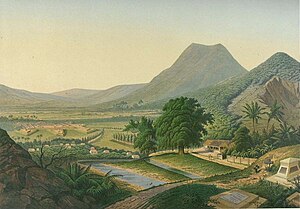Fort Willem I, Ambarawa

Fort Willem I, known in Indonesian/Javanese as Benteng Pendem Ambarawa (Ambarawa's Sunken Fort), is a 19th-century Dutch fortress in Ambarawa, Central Java, Indonesia.[1]

History[edit]
During the Diponegoro War (1827-1830), Colonel Hoorn, Commander of the 2nd Division, assigned to the crossroads at Bawen, instructed the construction of a logistical supply point, as well several military barracks, to give immediate supply and forces for the war, as Bawen is a vital junction connecting the cities of Semarang, Yogyakarta, Salatiga and Surakarta. As a result, several sheds, made out of bamboo, were built at this strategic point during the war.[1]
After the war, during the reign of Willem II, a fort was constructed in Ambarawa between 1834 and 1853. In 1840, Ambarawa had become a strategic military outpost, serving as a choke point between Semarang and Surakarta. The Dutch had also established several military defense points along this route. Their purpose was to establish a relationship with the Sultanate of Mataram and to prevent native troop movements.[1]
From 1853 to 1927 KNIL military barracks were set up in the fort. The private Dutch East Indies Railway Company (NIS) received concession in 1862 to build a rail track connecting Semarang, Surakarta, Magelang and Yogyakarta with a branch toward Fort Willem I.[2] Construction started in 1863 and was completed in 1873.[2] An earthquake occurring on July 16, 1865, damaged some buildings inside the fort.[1] In 1927, Fort Willem I changed its function from a juvenile penitentiary into an adult and political prison.[1]
During the period of Japanese occupation, Fort Willem I was converted into an internment camp.[1]
After the Indonesian declaration of independence, from October 14, 1945, to November 23, 1945, parts of the fort were also used as a military base by the Tentara Keamanan Rakjat ("People's Security Army"), a predecessor of the Indonesian National Army. During which time, around 3,500 Dutch civilians were interned by Indonesian freedom fighters inside the Fort Willem I; the internment camp used former prisoners and guards for camp security.[1]
In 1950, parts of the fort were converted into an adult penitentiary. In 1985, it was repurposed yet again as a juvenile penitentiary facility; in 1991, penitentiary class IIB; in 2003 and until now, penitentiary class IIA.[1]
Structure[edit]
Fort Willem I is situated in the middle of a rice field. The main building is a pentagonal fort, sized around 178 x 178 meter. Small storage buildings are located around 94 meter away from the fort at each cardinal points.
Unlike earlier 18th-century fort designs, the 19th-century Willem I Fort were designed for a mainly defensive and logistical purpose. As such, the fort contains no embrasures or bastions. Instead, there are many windows in the rampart, and the bastions are detached from the fort.[1]
References[edit]
Notes[edit]
Bibliography[edit]
- M. Sahari Besari (2008). Reza Anggara (ed.). Teknologi di Nusantara: 40 abad hambatan inovasi [Technology in Nusantara: 40 centuries of obstacles in innovation] (in Indonesian). Jakarta: Penerbit Salemba Teknika. ISBN 9789799549259.
- Mahandis Yoanata (October 12, 2009). "INSIDE FORT WILLEM I AT AMBARAWA". My Odyssey. Blogspot. Archived from the original on November 28, 2015. Retrieved November 28, 2015.
